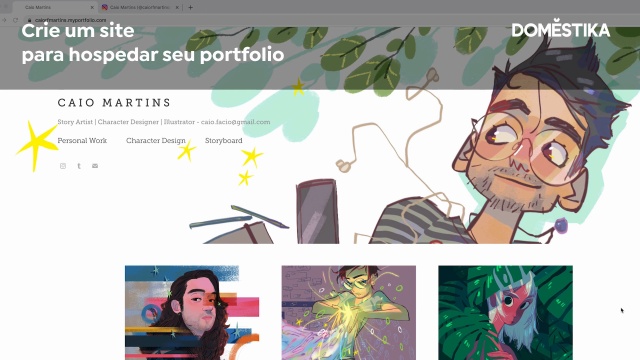Animation Tutorial: How to Prepare a Portfolio to Send to Studios

Learn how to organize and present the animations in your portfolio, with Caio Martins
If you are an animator or illustrator, having an online portfolio is important to get jobs. However, many creatives do not know where to start or what to prioritize when creating their collection of works and creations. In this video, Caio Martins, illustrator, character designer and storyboard artist shows us how create and organize an effective animation portfolio:
1. Organize your portfolio by theme
Start by organizing the work into themes, such as illustration (general), characters, watercolor, video, etc. Choose the themes according to the volume of things you have produced, prioritising those you create most often. You can also create sections dedicated to the work you do with a particular brand, a film you may have contributed to, or older work. Use your creativity to organize your material, but remember: it is essential to always emphasize what is most important to your style.

2. Use Instagram to spread the word about your work
Instagram is almost a second portfolio today, it allows a freer, more informal approach. Use it to publish your sketches, references, and creations. In your profile description, don't forget to add a link to your official portfolio, where you keep everything more organized and in order of importance.
Through Instagram, people will be able to get to know your style and technique, as well as get a good idea of what you are capable of doing. It is very common to receive work proposals there. So, don't forget to include an updated contact form that goes beyond the direct messaging on the platform itself.

3. Use current hashtags
Instagram hashtags are a great way to get to know the work of other creatives–and they also allow your creations to spread. Take part in the challenges that other illustrators propose on the platform, such as #Mermay, which, filled IG with mermaids during the month of May; or #sixfanarts and #drawingchallenge. Through these hashtags, you will be able to make contacts, network, and make your own work more relevant to your social network–which, of course, will result in more visibility for your work.

4. Create a website to host your portfolio
You may be asking yourself: if I have Instagram as a showcase, why create a website? Besides allowing a clearer and more personalized organization, the web is a space where you have more control over everything that is published and how. It is also an important tool if you want to improve your SEO and come up in Google searches. In other words: create and keep your website and Instagram profile updated at the same time. Although they appear to be similar, they have different and complementary purposes.

5. Showcase your creative process
One of the sections of your portfolio should cover the 'making of' part of your work, detailing each stage of your creative process. It is important to show how you work, from sketch to final result. This isn’t just an interesting opportunity to go behind the scenes: studios will often want to see how you work and, if they like how you do things, as well as what you do, your chances of catching their eye are improved that bit more.

6. Highlight your skills through your projects
Analyze whether all the topics and sections chosen of your portfolio highlight your skills and make it clear what you do best. Those who go on your portfolio should clearly and quickly understand what you do and what you excel at. In the end, it will be these skills that will guarantee you better and better jobs.

7. Include a contact email and links to your socials
Another essential point is to leave a contact email in an easily accessible area, without hiding it in a "Contact me" section or anywhere else. It is often smart to put it on the front page, and even better to have it near the links to your social networks. These are equally important, as they reveal other elements about you and your work, especially if you publish content often.
Did you like these tips? Learn to bring a cartoon character to life, from briefing to model sheet, in Caio Martins online course Character Design for Animation with Photoshop.
You may also like:
- From Beginner to Superillustrator, a course by Puño
- Digital Fantasy Portraits with Photoshop, a course by Karmen Loh (Bearbrickjia)
- Adobe Photoshop for Illustration, a course by Gemma Román






0 comments